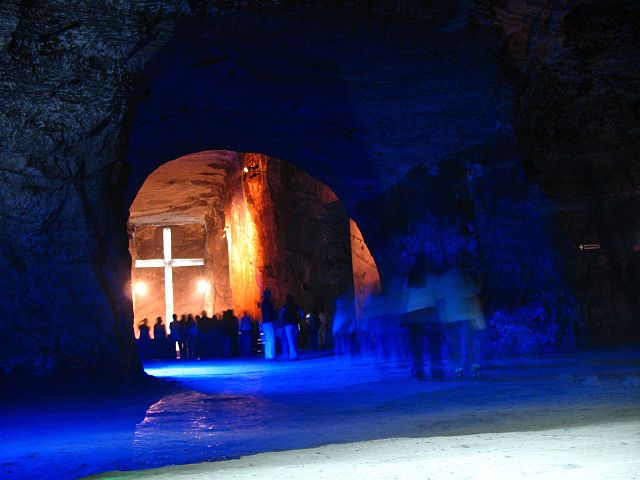
Sodium chloride has been a world-shaping mineral indeed, prized back into antiquity and beyond, and over the centuries contributing to the growth of trade and even civilization itself in various parts of the world. And though much of it has come from the ocean and open-air salt ponds, a good deal of salt has been mined from underground as well. On a recent trip to Colombia I had the pleasure of visiting a very cool salt mine (both figuratively and literally), which in turn brought to mind another fascinating example I experienced on a visit to Poland some years ago.
 In the town of Zipaquirá, in Colombia’s Cudinamarca department about 30 miles (49 km) from capital Bogota, there has been an underground salt mine since at least the 5 century BC, worked by the Muisca peoples, and of course it became an increasingly bigger deal as part of colonial Nueva Granada, then independent Colombia. In the 1930s miners carved out a religious sanctuary that by 1954 had become a full-fledged cathedral, 394 feet (120 metres) long, 72 feet (22 m.) high, and able to hold 8,000 people. Impressive as this was, there were structural and safety issues, so it was closed and in 1995 a new Catedral de Sal was inaugurated here at 590 ft. (180 m.) underground (it’s no longer a working salt mine). These days it’s a major tourist attraction, with tours of the cathedral, of the miners’ tunnels, and the salt processing areas, plus a 3-D video and even a rock-climbing wall. And it’s a marvelously atmospheric space – helped by strategic lighting of course – including not just the main three-nave space but 14 mini chapels representing the stations of the cross.
In the town of Zipaquirá, in Colombia’s Cudinamarca department about 30 miles (49 km) from capital Bogota, there has been an underground salt mine since at least the 5 century BC, worked by the Muisca peoples, and of course it became an increasingly bigger deal as part of colonial Nueva Granada, then independent Colombia. In the 1930s miners carved out a religious sanctuary that by 1954 had become a full-fledged cathedral, 394 feet (120 metres) long, 72 feet (22 m.) high, and able to hold 8,000 people. Impressive as this was, there were structural and safety issues, so it was closed and in 1995 a new Catedral de Sal was inaugurated here at 590 ft. (180 m.) underground (it’s no longer a working salt mine). These days it’s a major tourist attraction, with tours of the cathedral, of the miners’ tunnels, and the salt processing areas, plus a 3-D video and even a rock-climbing wall. And it’s a marvelously atmospheric space – helped by strategic lighting of course – including not just the main three-nave space but 14 mini chapels representing the stations of the cross.

My first salt mine, though, was some years earlier, near the city of Cracow, Poland (as well as the notorious Auschwitz concentration camp, which was part of the same bus tour I took). Established in the 13th century, the UNESCO World Heritage Site Wieliczka Salt Mine is even deeper (1,073 ft./327 m.), larger (more than 178 miles/287 km. of tunnels), and more elaborate than Zipaquirá’s; you have to take an elevator down, instead of just strolling down a tunnel. Here there are not just several chapels and a cathedral (above), but a bevy of statues ranging from medieval to contemporary, along with an underground lake. There’s even a mini “health resort” specializing in “subterranotherapy” for things like respiratory ailments and allergies (apparently the allergen-free microclimate is just what the doctor ordered). They have all sorts of concerts and events down here, too (even stuff like bungee jumping - ah, those crazy Poles, what they won't do for a salty thrill). Again, you get to tour the miners' tunnels, as well. And here I got a souvenir - a chunk of salt crystal (right) I still display in my living room.
Two spots identical in purpose but quite different in feel. And indelible travel memories that are, um, mine, all mine.
images | Vero Villa, Tijs Twinkels, Wieliczka Salt Mine, José Balido
Comments